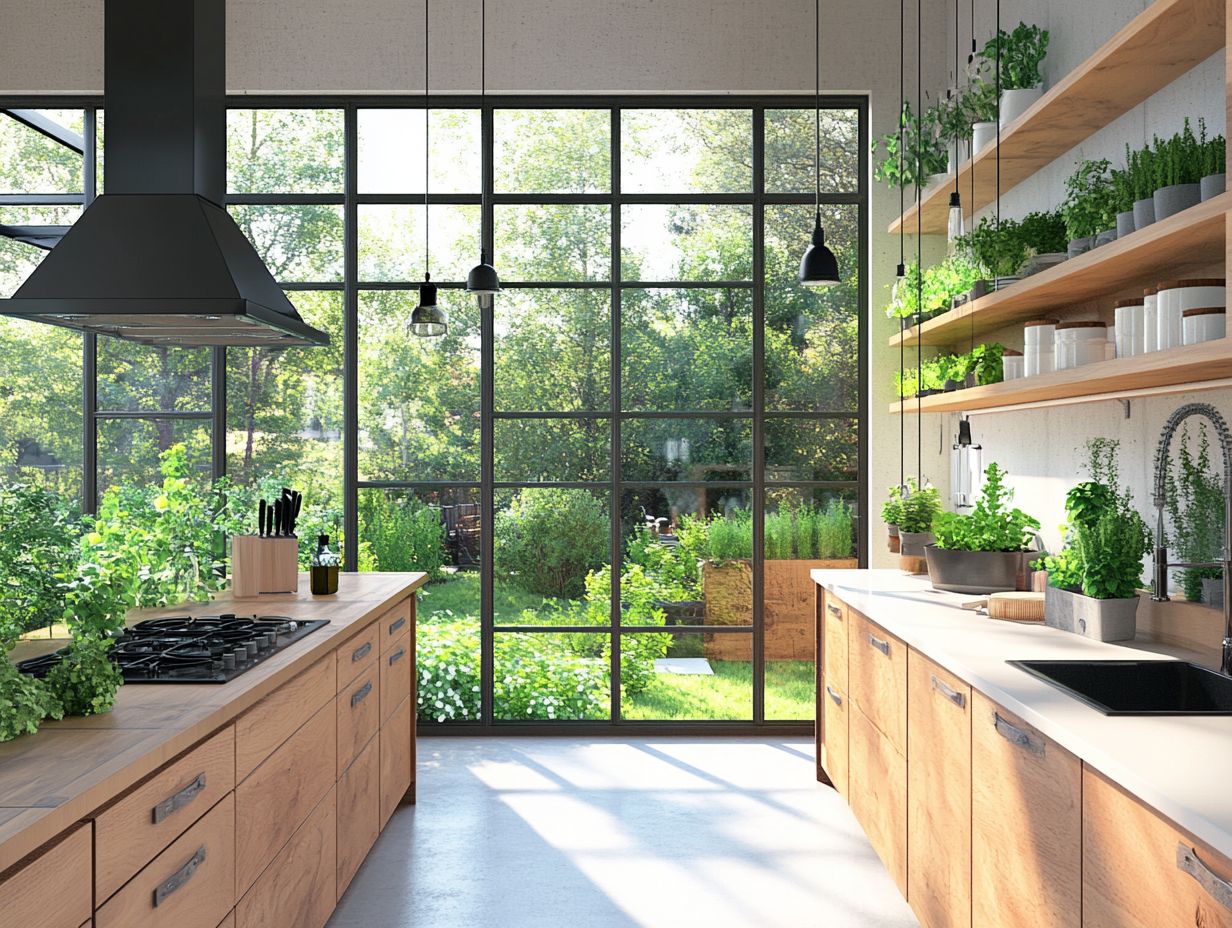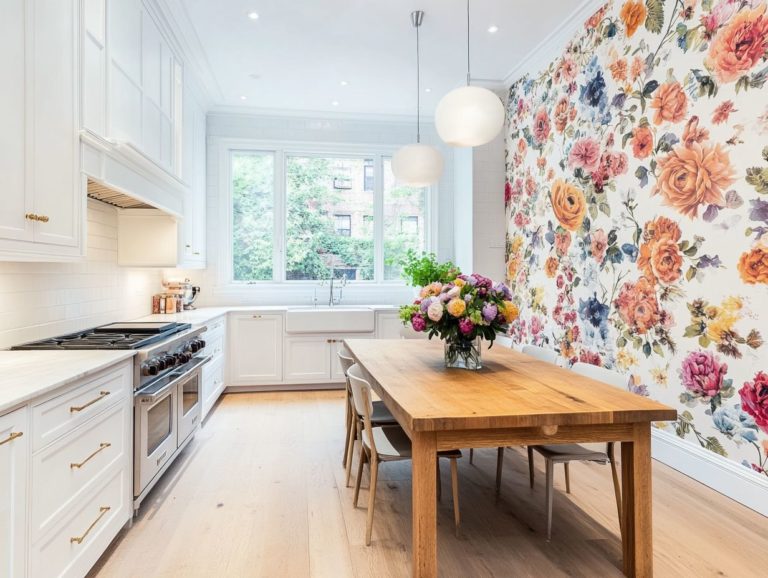Incorporating Nature into Kitchen Designs
Imagine stepping into a kitchen that pulses with life, vibrant and seamlessly connected to the outdoors.
Bringing nature into your kitchen enhances your mental and physical well-being, creating a more inviting space for cooking and gathering.
Explore the benefits of a nature-inspired kitchen—from using natural materials and maximizing light to embracing plants and sustainable practices.
These elements can revolutionize your cooking experience, making it healthier and more enjoyable. Create a kitchen that embodies the spirit of nature—a sanctuary where culinary creativity flourishes!
Contents
- Key Takeaways:
- The Benefits of Bringing Nature into the Kitchen
- Designing a Nature-Friendly Kitchen
- Plants in the Kitchen
- Creating a Sustainable Kitchen
- Eco-Friendly Materials and Practices
- Bringing Nature into Everyday Cooking
- Frequently Asked Questions
- What are some ways to incorporate nature into kitchen designs?
- Why should I incorporate nature into my kitchen design?
- How can I add natural materials into my kitchen design?
- What types of plants are best for adding to kitchen designs?
- Can you add nature to kitchen designs on a budget?
- Are there downsides to adding nature to kitchen designs?
Key Takeaways:
- Bringing nature into the kitchen improves mental and physical health, making it more relaxing and enjoyable.
- Design a nature-friendly kitchen by incorporating natural materials and colors, maximizing natural light and views, and adding plants.
- Create a sustainable kitchen with eco-friendly materials and practices, supporting a healthier environment for your home and the planet.
The Benefits of Bringing Nature into the Kitchen
Incorporating nature into your kitchen can greatly enhance your mental and physical well-being. It creates a vibrant environment that promotes health and happiness.
E.O. Wilson’s concept of biophilia highlights our connection to nature. Integrating elements like greenery and plants into your kitchen elevates its appeal and improves air quality.
By using natural materials such as wood and stone, along with natural light, you can cultivate an inviting space that fosters well-being and boosts productivity.
Improved Mental and Physical Health
Integrating natural elements into your kitchen design significantly impacts mental and physical health. It creates a health-promoting environment for everyone who spends time there.
Research shows that designs infused with plants, abundant natural light, and organic materials enhance cognitive function and lower stress levels.
A study in the Journal of Environmental Psychology found that individuals in greenery-rich environments reported feeling less fatigued and enjoyed improved focus.
Natural light exposure boosts serotonin levels, improving your mood and promoting overall well-being.
With these elements in your kitchen, you may experience heightened mindfulness and creativity while preparing meals, leading to healthier eating habits and more meaningful family interactions.
Designing a Nature-Friendly Kitchen
Designing a nature-friendly kitchen focuses on biophilic design principles, emphasizing natural materials and earthy aesthetics that connect to the outdoors.
This approach enhances visual appeal and aligns with sustainable design principles, making it an eco-conscious choice for environmentally aware homeowners.
Integrating elements like wooden cabinets, granite countertops, and lush greenery can create a vibrant and welcoming space.
Incorporating Natural Materials and Colors
Using natural materials and earthy color palettes is essential for crafting a biophilic kitchen that exudes warmth and invites connection with nature.
Consider beech wood cabinetry paired with walnut worktops. This combination enhances functionality and creates a visually striking space that feels rich and organic.
Soft greens, whether as wall paint or accent decor, evoke tranquility reminiscent of lush landscapes. These elements harmonize beautifully, transforming the kitchen into a serene hub for culinary creativity.
Including such materials fosters a calming atmosphere that uplifts moods and improves overall well-being, turning an ordinary kitchen into a rejuvenating sanctuary.
Start your kitchen transformation today and embrace the benefits of a nature-friendly space!
Maximizing Natural Light and Views

Maximizing natural light and views in your kitchen is crucial for enhancing the biophilic design concept, which connects your home to nature, and crafting an inviting atmosphere. By thoughtfully incorporating large windows, skylights, and open layouts, you can make the most of the sun’s warming rays and captivating vistas.
These choices bathe your space in natural light and create a seamless connection to the outdoors, significantly uplifting your mood.
Place a large window above the sink or install a skylight; these elements can transform your cooking experience, making it feel airy and vibrant.
An open layout that flows into adjacent living areas enhances both functionality and visual appeal. It promotes efficient space use while maximizing daylight exposure. Ultimately, these choices lead to improved energy efficiency, making your kitchen not just a culinary hub but a bright, uplifting environment.
Plants in the Kitchen
Integrating plants into your kitchen elevates its visual allure and enhances air quality, transforming your space into a vibrant biophilic haven.
Indoor plants, whether fresh herbs or lush foliage, create a lively space that mirrors the biodiversity of gardens, infusing your cooking area with refreshing vitality.
You can effortlessly weave plants into your kitchen design by selecting varieties that thrive indoors and resonate with your personal aesthetic.
Best Plants for the Kitchen Environment
Choosing the best plants for your kitchen means selecting varieties that are visually appealing and enhance air quality.
Incorporating indoor plants significantly elevates biophilic design, fostering a deeper connection to nature within your home. Consider options like basil, mint, and rosemary—they’re practical choices for any kitchen.
These herbs thrive in bright light and bring culinary benefits to the table. They not only add fresh flavors to your dishes but also require minimal maintenance, making them perfect for your busy lifestyle.
Their aromatic qualities can transform the kitchen’s ambiance, creating a more inviting and vibrant space. Start integrating these plants today for a vibrant kitchen that offers both aesthetic charm and functional perks, nurturing a healthier home environment.
Caring for Kitchen Plants
Taking care of your kitchen plants is key to thriving greenery! Understanding their specific needs is vital for ensuring they thrive in your biophilic kitchen environment.
These green companions not only beautify your space but also offer practical benefits, such as providing fresh herbs for your culinary creations and serving as natural air purifiers.
Proper watering is crucial; most kitchen plants prefer to dry out slightly between waterings to avoid root rot. Consider their light exposure as well; placing them near a window with indirect sunlight usually fosters optimal growth.
Selecting the right soil mix is equally important—opt for one that provides good drainage while retaining moisture to significantly improve plant health.
By nurturing these plants, you can savor the dual benefits of culinary enhancement and a cleaner indoor atmosphere.
Creating a Sustainable Kitchen
Let’s build a sustainable kitchen that’s both beautiful and eco-friendly! Focus on integrating eco-friendly materials and sustainable design principles.
This approach enhances environmental responsibility and aesthetic appeal, seamlessly aligning with the biophilic kitchen concept.
Embracing these elements allows you to cultivate a space that not only looks good but also honors the planet.
Eco-Friendly Materials and Practices

Utilizing eco-friendly materials and sustainable practices is essential for creating a biophilic kitchen that honors the environment. This approach enhances both health and aesthetics.
Integrate elements like bamboo cabinetry, recycled glass backsplashes, and paints with fewer harmful chemicals for wall finishes. These choices not only cultivate a visually stunning space but also foster a healthier living environment.
Bamboo is celebrated for its rapid growth and durability, making it a remarkable renewable resource. Meanwhile, recycled glass adds elegance while diverting waste from landfills.
Using paints with fewer harmful chemicals lowers emissions, enhancing indoor air quality—an important consideration in a kitchen where you prepare food.
These mindful choices showcase your commitment to sustainability without sacrificing style.
Bringing Nature into Everyday Cooking
Transform your cooking effortlessly with the beauty of nature!
Incorporating fresh herbs into your dishes elevates flavors and nurtures a deeper connection to the natural world.
Creating outdoor cooking spaces transforms your kitchen experience, allowing you to savor the sights, sounds, and scents of nature while you prepare your meals.
Using Fresh Herbs and Ingredients
Using fresh herbs and ingredients elevates the flavor and deepens your connection to a biophilic kitchen environment. This connection invites you to appreciate the full life cycle of your food, from seed to plate.
Consider cultivating popular herbs, whether indoors or outdoors, such as:
- Basil
- Cilantro
- Rosemary
- Mint
Each herb adds its own unique aroma and flavor, transforming ordinary dishes into culinary delights. For example, basil shines in Italian cuisine, while cilantro adds a refreshing burst in salsas and salads.
To ensure your herbs flourish, provide them with ample sunlight, well-draining soil, and consistent watering. Growing herbs at home guarantees fresh ingredients, supports sustainability, and can lighten your grocery bills.
Incorporating Outdoor Cooking Spaces
Incorporating outdoor cooking spaces into your kitchen design enhances your connection to nature. This approach elevates meal preparation and cultivates an enjoyable atmosphere, blending the joys of cooking with the tranquility of the outdoors.
Use natural materials like wood, stone, and metal in your outdoor kitchen to mirror the surrounding environment. This provides a durable and visually appealing surface for food preparation. The fresh air invigorates your senses and can spark new culinary inspirations.
To create harmony between your indoor and outdoor cooking areas, use matching materials and color palettes. For instance, if your indoor kitchen has warm wood tones, replicate those in the outdoor setup for a cohesive flow.
Installing sliding glass doors enhances this transition, allowing for a seamless and inviting experience between the two spaces.
Frequently Asked Questions
What are some ways to incorporate nature into kitchen designs?

Some ways to incorporate nature into kitchen designs include adding natural materials such as wood or stone, incorporating plants or flowers, and using earthy color palettes.
Why should I incorporate nature into my kitchen design?
Incorporating nature into kitchen designs creates a calming and inviting space, adding a touch of natural beauty. It promotes a healthier lifestyle by encouraging the use of fresh, natural ingredients in cooking.
How can I add natural materials into my kitchen design?
Add natural materials such as wood or stone for flooring, countertops, or cabinets. Consider incorporating natural textiles like bamboo or linen for window treatments or kitchen linens.
We invite you to share your experiences or ideas about nature in kitchen design below!
What types of plants are best for adding to kitchen designs?
Herbs, succulents, and low-maintenance plants like pothos or snake plants thrive in a kitchen. They boost both the look and the function of your space.
Can you add nature to kitchen designs on a budget?
Absolutely! You can use faux plants or flowers, add natural textures with textiles or wall decor, and choose budget-friendly materials.
Are there downsides to adding nature to kitchen designs?
One downside is maintenance. Plants need regular watering and care, which can be a fun ritual!
Too many natural elements can make the kitchen feel cluttered and overwhelming.





